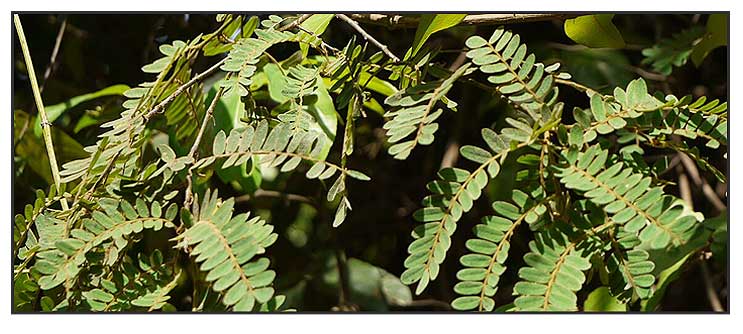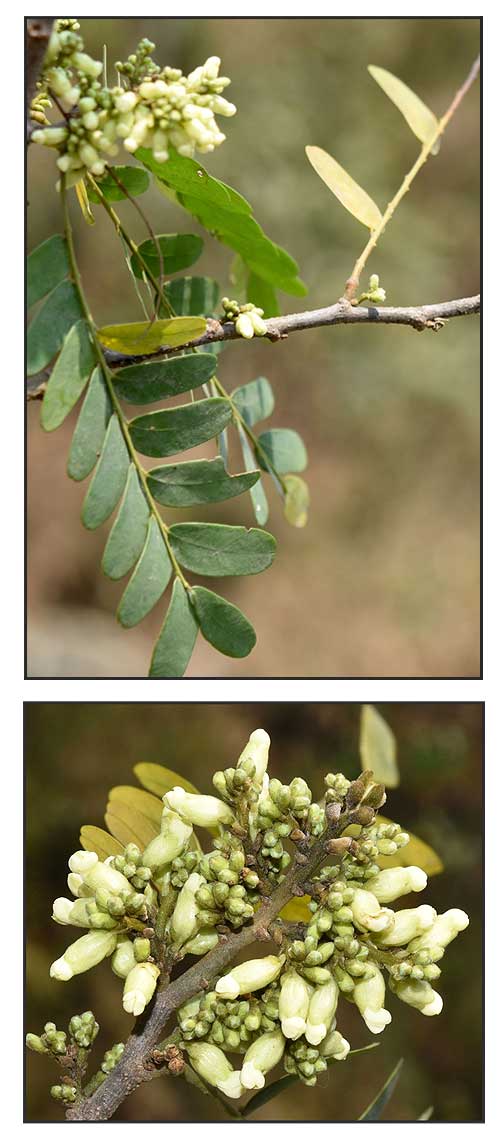
Family • Fabaceae
Tikos-maiadon
Dalbergia pinnata (Lour.) Prain
PINNATE LEAF ROSEWOOD
Xie ye huang tan
| Scientific names | Common names |
| Amerimnon pinnatum (Lour.) Kuntze | Tikos-maladon (Manobo) |
| Dalbergia pinnata (Lour.) Prain | Pinnate leaf rosewood (Engl.) |
| Derris pinnata Lour. | Pinnate rosewood (Engl.) |
| Accepted infraspecifics (2) | |
| Dalbergia pinnata var. acaciifolia (Dalzell) Thoth. | |
| Dalbergia acaciifolia Dalzell | |
| Dalbergia pinnata var. pinnata | |
| Derris blumei Hassk. | |
| Derris dubia Elmer | |
| Derris multijuga Graham | |
| Derris pinatubensis Elmer | |
| Derris pinnata var. badia Merr. | |
| Derris tamarindifolia Roxb. | |
| Endespermum retusum Blume | |
| Dalbergia pinnata is an accepted species. KEW: Plants of the World Online | |
| Other vernacular names |
| CHINA: Xie ye huang tan. |
| INDONESIA: Areuy ki loma (Sundanese), Oyod sambang (Java), Jampak luyak (Lampung). |
| MALAYSIA: Semelit jangkar, Lorotan haji (Peninsular). |
| NEPALI: Daamar. |
| VIETNAM: Cham bia an trau (Vin Phu), Trac la me. |
 Gen info Gen info- Dalbergia is a large genus of small to medium-sized trees, shrubs, and lianas in the pea family, Fabaceae.It was recentlyt assigned to the informal monophyletic Dalbergia clde (tribe): Dalbergiaea. Many species are important timber trees, valued for the decorative and often fragrant wood, rich in aromatic oils. The most famous of these are the rosewoods, so called because of the smell of the timber when cut. (4) - Etymology: The genus name Dalbergia honors the Swedish botanist Carl Dahlberg. The specific epithet pinnata means "feather-like", referring to the compound leaves with leaflets arranged along a central stalk.  Botany Botany• Trees or sometimes shrubby climbers. Branches long, flexuose; young branchlets puberulent. Leaves 12-15 cm; rachis and petioles densely puberulent as short petiolules; stipules lanceolate, ca. 5 mm, puberulent; leaflets 21-42, trapezoid-oblong, small, 12-18 × 5-7.5 mm, firmly papery, both surfaces puberulent, at length abaxially glaucous, adaxially glabrescent, base asymmetric, apex rounded, slightly emarginate. Panicles axillary, congested, with corymblike branches, 1.5-5 × 1.2-2.5 cm; peduncles short, as branches and pedicels densely puberulent; bracts and bracteoles persistent, ovate, puberulent. Flowers small, ca. 6 mm. Calyx campanulate, ca. 3 mm, outside puberulent or glabrescent; teeth ovate, upper 2 subconnate. Corolla white; petals long clawed; standard reflexed, ovate; wings with sagittate base; keel united above, blade hastate on upper side below. Stamens 9 or 10, monadelphous. Ovary stipitate, glabrous; ovules 2 or 3. Legume brown and shiny when dry, oblong-ligulate, thin, 2.5-6 × 1-1.4 cm, glabrous, uniformly finely reticulate, base attenuate to long slender stipe, acute, 1-4-seeded. Seeds narrow, ca. 18 × 4 mm. (Flora of China) Distribution Constituents Properties Availability |
November 2025
![]()
 |
| PHOTOS / ILLUSTRATIONS |
| IMAGE SOURCE: Dalbergia pinnata / Dinesh Valke / CC BY-SA 2.0 Generic / Image modified / Click on image or link to go to source page / Wikimedia Commons |
| OTHER IMAGE SOURCE: Dalbergia pinnata / eFloraofIndia / 2 images / Non-commercial use / Images modified / Click on image or link to go to source page / eFloraofIndia |
| OTHER IMAGE SOURCE: Dalbergia pinnata - Leaves and pod / eFloraofIndia / Non-commercial use / Images modified / Click on image or link to go to source page / eFloraofIndia |
Additional
Sources and Suggested Readings |
• |
DOI: It is not uncommon for links on studies/sources to change. Copying and pasting the information on the search window or using the DOI (if available) will often redirect to the new link page. (Citing and Using a (DOI) Digital Object Identifier) |
| List of Understudied Philippine Medicinal Plants |
| New plant names needed The compilation now numbers over 1,730 medicinal plants. While I believe there are hundreds more that can be added to the collection, they are becoming more difficult to find. If you have a plant to suggest for inclusion, native or introduced, please email the info: scientific name (most helpful), local plant name (if known), any known folkloric medicinal use, and, if possible, a photo. Your help will be greatly appreciated. |
• |
 |


